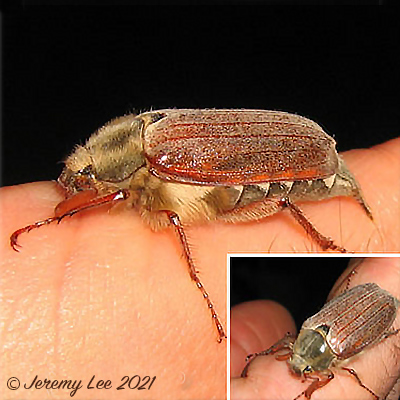
 |
|
Scientific Classifications explained » Amphibians » Ants » Aphids » Bees » Beetles » Birds » Bugs » Butterflies » Caterpillars » Damselflies » Dragonflies » Earwigs » Flies » Frog/Leafhoppers » Fungi » Galls » Grasshoppers » Harvestmen » Hoverflies » Lacewings » Ladybirds » Leaf Mines » Lichens » Mammals » Millipedes » Mosses » Moths » Sawflies » Slugs » Snails » Spiders » Trees & Shrubs » Wasps » Wild Flowers » Woodlice » Postboxes |
UK Nature > Beetles > Melolontha melolontha

Scientific Name: Melolontha melolontha Common Name: Common Cockchafer, May Bug Melolontha melolontha, or the Common Cockchafer, is 20-30mm in length, with a hairy black thorax and truncated rust-coloured elytra that leave the pointed tip of the abdomen exposed. The antennae, larger in the male (pictured here) than the female, can open out like a fan. Chews the leaves of a variety of deciduous trees and shrubs, often swarming around them at dusk and commonly crashing into lighted windows (the pictured specimen blundered into my son's bedroom late one May evening through the open window). Appearing usually in May (hence the other common name for this insect - May Bug) through to July. The plump, white, C-shaped larva lives in the soil for 3 years and causes severe damage at times to cereals and other field crops. Inhabits woodland margins, hedgerows, parks and gardens, although the females usually lay their eggs in more open habitats. Fairly common throughout the UK. |
|

https://www.uknature.co.uk is a website dedicated to showing the immense diversity of UK nature and wildlife. Our vast range of habitats, from lowland arable to snow covered mountains, from storm-ravaged coastlines to peaceful inland freshwater lakes and rivers, from dry, sandy heaths to deciduous and coniferous forests, all these habitats contribute to the abundance of UK nature. We have wild birds in huge numbers either residing or visiting our shores (597 recorded species as at July 2013) and we must also not forget the humble back garden with its grass lawns, flower beds filled with nectar rich flowers, shrubs and trees, all designed to attract huge numbers of insects such as bees, moths, butterflies and hoverflies; and finally the small ponds which provide safe havens for frogs, toads, newts and even slow worms and grass snakes. www.uknature.co.uk is the showcase for my personal passion, photographing uknature in all its glory. I sincerely hope you all enjoy the fruits of my labours. This site and all images contained therein is © Jeremy Lee 2004 - 2025. All Rights Reserved. Site design by Jeremy Lee. Site development & IT Support by Stuart Lee. |